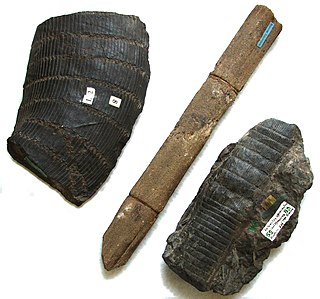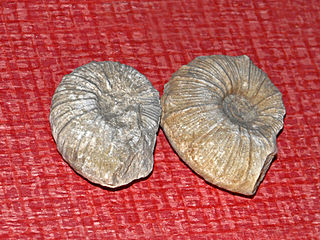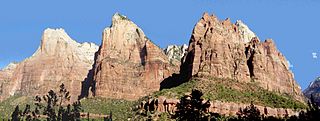
Acteonidae, common name the "barrel bubble snails", is a family of small sea snails, marine gastropod mollusks of the informal group Lower Heterobranchia.

In botany, a staminode is an often rudimentary, sterile or abortive stamen, which means that it does not produce pollen. Staminodes are frequently inconspicuous and stamen-like, usually occurring at the inner whorl of the flower, but are also sometimes long enough to protrude from the corolla.

Calamites is a genus of extinct arborescent (tree-like) horsetails to which the modern horsetails are closely related. Unlike their herbaceous modern cousins, these plants were medium-sized trees, growing to heights of more than 30 meters (100 feet). They were components of the understories of coal swamps of the Carboniferous Period.

Helicoprion is a genus of extinct, shark-like eugeneodontid holocephalid fish. Almost all fossil specimens are of spirally arranged clusters of the individuals' teeth, called "tooth whorls"— the cartilaginous skull, spine, and other structural elements have not been preserved in the fossil record, leaving scientists to make educated guesses as to its anatomy and behavior. Helicoprion lived in the oceans of the early Permian 290 million years ago, with species known from North America, Eastern Europe, Asia, and Australia. The closest living relatives of Helicoprion are the chimaeras.

The body whorl is part of the morphology of the shell in those gastropod mollusks that possess a coiled shell. The term is also sometimes used in a similar way to describe the shell of a cephalopod mollusk.

A whorl is a single, complete 360° revolution or turn in the spiral growth of a mollusc shell. A spiral configuration of the shell is found in of numerous gastropods, but it is also found in shelled cephalopods including Nautilus, Spirula and the large extinct subclass of cephalopods known as the ammonites.

Tube-dwelling anemones or ceriantharians look very similar to sea anemones but belong to an entirely different subclass of anthozoans. They are solitary, living buried in soft sediments. Tube anemones live inside and can withdraw into tubes, which are composed of a fibrous material made from secreted mucus and threads of nematocyst-like organelles known as ptychocysts. Ceriantharians were formerly classified in the taxon Ceriantipatharia along with the black corals but have since been moved to their own subclass, Ceriantharia.
Bradfordia is a moderately involute to involute genus included in the ammonoid cephalopod family Oppeliidae, coiled so that the outer whorl encloses most, or much, of the previous, but with a small umbilicus exposing inner whorls. The shell is compressed, whorl height much greater than width, extending well out from the contact with the adjacent inner whorl. Outer flanks are finely ribbed and the rounded venter is smooth.

Placenticeras is a genus of ammonites from the Late Cretaceous. Its fossils have been found in Asia, Europe, North and South America.

Euomphalus is a genus of fossil marine gastropods known to have lived from the Silurian to the Middle Permian.

Peltoceras is an extinct ammonite genus from the aspidoceratid subfamily Peltoceratinae that lived during the later part of the Middle Jurassic.

Annularia is a plant fossil belonging to the order Equisetales.
Liroceras is a genus of nautiloid cephalopod. It is the type genus of the clydonautiliacean family, Liroceratidae, and is characterized by a rapidly expanding, subglobular, nautiliconic shell with a reniform whorl section, small umbilicus, essentially straight sutures, and a siphuncle with a variable but not marginal position.

Forresteria is an extinct genus of cephalopod belonging to the subclass Ammonoidea. They flourished during the late Turonian and early Coniacian of the Late Cretaceous, and were global in extent. Forresteria alluaudi and Forresteria hobsoni are considered marker fossils for the lower Coniacian in the American West.

Hauericeras is an ammonite genus from the Late Cretaceous that lived from the Coniacian to the late Maastrichtian, from about 90 to 66 mya. Fossils have been found in Europe, Russia, South Africa, Australia, India, Iraq, and in the United States.

Harpoceras is an extinct genus of cephalopod belonging to the family Hildoceratidae. These cephalopods existed in the Jurassic period, during Toarcian age from Falciferum zone to Commune subzone of Bifrons zone. They were fast-moving nektonic carnivores.

Holcodiscus is an ammonite genus placed in the family Holcodiscidae. Species in this genus were fast-moving nektonic carnivores. The type species of the genus is Ammonites caillaudianus.
Radstockiceras is an extinct genus of lower Jurassic ammonite that lived from Oxynotum zone of upper Sinemurian to Raricostatum zone of lower Pliensbachian. Shells of these animals were oxycone and involute with umbilicus that took maximum of 12% of diameter in the case of outer whorls. On inner whorls, venter has been sharp, but then it became rounded. Faint ribs had falcoid shape, but sometimes, ribs could absent. Shells could have been large in their size. Suture has been very complex, similar to Oxynoticeras, but culmination at umbilical margin has been missing. Genus has been named after town of Radstock, in Somerset.
Porpoceras is genus of ammonite that lived during the early and middle Toarcian stage of early Jurassic. Members of this genus existed from uppermost part of Serpentinum Zone to Variabilis Subzone. Their fossils were found in Europe, Asia, North America and South America.
Nodicoeloceras is genus of ammonite that lived during early to middle Toarcian stage of early Jurassic. Members of this genus existed from Exaratum Subzone of Falciferum Zone to Commune subzone of Bifrons Zone. Their fossils were found in Europe, northern Africa, Asia, North America and South America. It has probably evolved from Dactylioceras (Orthodactylites) or Kedonoceras and gave rise to Mesodactylites.















